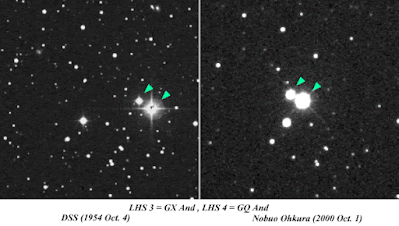It was the image I have used in my talks on measuring double stars, emphasising common proper motion (CPM).
The image by Ohkura shows a pair of stars moving to the left over the course of 50 years. They maintain the same position and angle to each other but move together against the background stars.
She specifically inquired about the labelling. "Do you know about the numbers directly under the photos? I get Andromeda [constellation] but what does LHS 3=GX and LHS 4=GQ mean?" She wanted to know in case someone asks during her upcoming Nova East talk.
I did a deep dive (as usual)...
"LHS 3 = GX And, LHS 4 = GQ And" means that one of the stars is known has LHS 3 or GX And. And the other star is known as LHS 4 or GQ And. The imager or researcher used the equality symbol (=) as the word "or" to mean "it's called this or that".
The comma (,) is a separator for a short list, indicate two items, the two stars. Although there's an issue with that (which I discuss later)... Again, the GX is one of the stars, the GQ is a different star.
Finally if it is not obvious "And" does not mean "and."
This is a rather specialised catalogue so not commonly referred to except for fast-moving stars (e.g. Barnard's). In general, LHS designations are not used in SkyTools.
Stars with two letters and the constellation are usually variable stars. So one might have greater luck finding these stars by the two-letter designation in Stellarium or Sky Safari or SkyTools, etc. For example, if one looks up GX Andromedae, you'll land at the double (multi-) star system, well known as Groombridge 34 (GRB 34). And that's the primary [discoverer] in the WDS.
I examined Stelle Doppie.
GX refers to the A and C stars while GQ refers to A and B.
LHS 3
WDS ID: 00184+4401 GRB 34AC
GX And - variable star name
GRB 34 (Groombridge) - prime WDS discoverer
Coord 00 18 22.88 +44 01 22.6
https://www.stelledoppie.it/index2.php?iddoppia=1218
i.e. the A and C pairing
separation: 227.0" (super-wide)
LHS 4
WDS ID: 00184+4401 GRB 34AB (CQ And)
CQ And - variable star name ***
GRB 34 - prime WDS discoverer
Coord 00 18 22.88 +44 01 22.6
https://www.stelledoppie.it/index2.php?iddoppia=1217
i.e. the A and B pairing
separation: 34.5" (close)
[Note! Stelle Doppie shows CQ for the AB pair. This appears to be a typo! It should be GQ. CQ And refers to a different star, at RA 02 31 32, Dec +45 56 37, over near Almaak.]
Stelle Doppie, as good as it is, does not show ALL the other designations for the components of this double.
It's better to use SIMBAD...
For example...
https://simbad.cds.unistra.fr/simbad/sim-basic?Ident=gx+and&submit=SIMBAD+search
pulls up GX And
also known as
HIP 1475
HD 1326
GRB 34
SAO 36248
and
LHS 3
I shared one other thought. The C star is not shown in the proper motion images! I think it is such a wide pair that it is out of frame. So it is actually a misleading label! Ha!
§
Melody replied, "How can a person to know all this information?!" Heh. Guess I'm an astro-nerd...
We confirmed various details.
Melody posited, "The stars in the photo are variable red dwarf stars in a binary relationship."
I shared that I didn't know about that. Not sure the stellar class.
Also: Binary? If one uses the word "binary" to casually to mean two stars, sure. But I use "binary" to mean "orbiting." These aren't orbiting (it seems).
She thanked me profusely. "I’d never have figured this one out!"
§
I looked up the LHS numbers for the CPM stars I image with BGO every year.
Barnard's Star: LHS 57
Wolf 359: LHS 36.
§
I re-examined Stelle Doppie.
Actually the AB pair is a binary! But it has a 2600 year period. The "grade" (or certainty) of the orbital data is 5 (out of 9). 1 is definite and 9 is indeterminate. So this is in the middle. We need more data! ;-)
Stelle does say for AB the system is "physical." We know that from CPM studies...
The spectral class of AB is:
M1V + M3.5V (red/red)
So they are red stars!
Unfortunately, there's no spectrum for the C star.
I forgot I imaged this with the BGO!
And I visually observed a couple of years after that.
Noted the colours.
A yellow-orange
B red
C blue or green
§
Processed GRB 34 in full colour on 27 Aug '22.



No comments:
Post a Comment